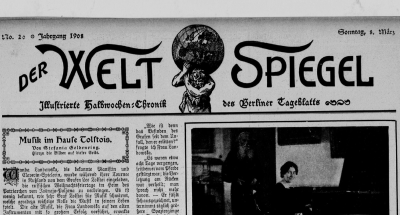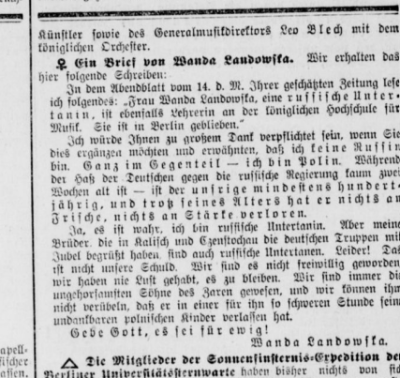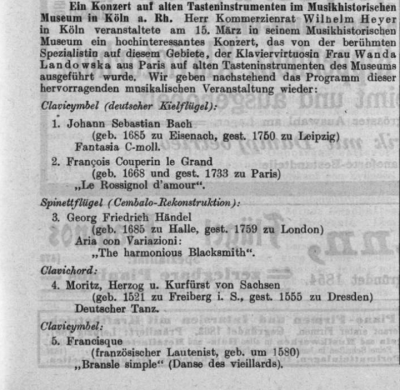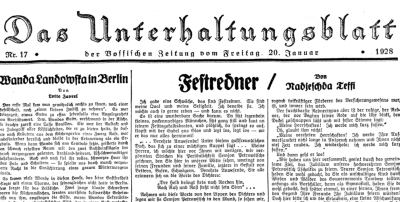Wanda Landowska

Landowska gave her last recital in Germany in 1930 with the Berlin Radio Orchestra in the Singing Academy there. From 1933 onwards she was defamed as a “Polish Jew” and “nauseating agitator against the new Germany”, who was “also suspected of spying against Germany”.[8] In 1938 an article by Brückner-Rock appeared in a national socialist lexicon of “Jewishness and Music with an ABC of Jewish and non-Aryan Music Enthusiasts”.[9] In the same year she took up French nationality. After German troops invaded France she fled to Banyuls-sur-Mer in the south of France on 10th June 1940, where she lived with her friend the sculptor Aristide Maillol. In September German musicologists from the “Sonderstab Musik” – it was part of the “Einsatzstab Reichleiter Rosenberg (ERR)”, a Nazi organisation specialising in looting cultural goods in the occupied countries – plundered her belongings in Saint-Leu-la-Forêt and confiscated her collection of instruments and her library consisting of 10,000 copies of sheet music, handwritten compositions and books, along with her paintings and valuable antiques to Berlin. (ill. ) In 1941 Landowska gave her last European recitals in Geneva and Lucerne. Thanks to the help of the Emergency Rescue Committee in Marseilles she emigrated from Lisbon to the USA on 29th November.
Landowska settled in New York where she resumed her masterclasses. In 1942 she gave her first recital with Bach’s Goldberg Variations in the New York City Hall. In 1950 she moved to Lakeville, Connecticut where, until 1954, she concentrated on recording the whole of Bach’s “Well-Tempered Clavier”. She died on 16th August 1959. Her urn was laid in the cemetery of Taverny, near Saint-Leu-la-Forêt. Some of the particularly important historic instruments which had been confiscated were brought from Berlin to South Germany in May 1943, and kept in Raitenhaslach monastery near Burghausen am Inn until 1945. In September 1945 the US army discovered the store of stolen art and took the instruments in the Landowska collection to the Central Art Collecting Point in Munich. From there they were transported to Paris in July 1946 and handed back to the French Commission de Recuperation Artistique following an official request.[10] In the decades after the Second World War other instruments came to light at international auctions. Landowska never received any compensation from the Federal Republic of Germany.
Axel Feuß, December 2015
Further reading:
Anonymous: Ein Konzert auf alten Tasteninstrumenten im Musikhistorischen Museum in Köln a. Rh., in: Zeitschrift für Instrumentenbau, vol. 31, Leipzig 1910/11, p. 723, 725
Alfred Heuß: Das kleine Bachfest in Eisenach, in: Zeitschrift der Internationalen Musikgesellschaft, 13, Leipzig 1911/12, p. 27-29
Arnold Schering: Das VI. deutsche Bachfest in Breslau, in: Zeitschrift der Internationalen Musikgesellschaft , 13, Leipzig 1911/12, pp. 365-368
Lotte Zavrel: Wanda Landowska in Berlin, in: Das Unterhaltungsblatt der Vossischen Zeitung, Nr. 17, Berlin, 20.1.1928
Ingeborg Harer: Landowska, Wanda, in: Die Musik in Geschichte und Gegenwart (MGG), ed. Ludwig Finscher, Personenteil 10, Kassel u.a., 2. edition, 2003
Martin Elste: Die Dame mit dem Cembalo. Wanda Landowska und die Alte Musik. Catalogue of the special exhibition in the Berlin Museum of Musical Instruments, Berlin 2009
Martin Elste (ed.): Die Dame mit dem Cembalo. Wanda Landowska und die Alte Musik, Mainz 2010 (with a discography of original recordings with Wanda Landowska)
[8] Report presumed to be from a student informer to the director of the university, Fritz Stein, Berlin 15 November 1933, reproduced in Martin Elste (publ.) 2010, p.107.
[9] Quoted and reproduced in Martin Elste (publ.) 2010, p. 125.
[10] Looting and Restitution. Case histories. Landowska, website of the Jewish Museum in Berlin, http://www.jmberlin.de/raub-und-restitution/de/landowska.php









![„Erinnerungen an Wanda Landowska” [‘Memories of Wanda Landowska’] „Erinnerungen an Wanda Landowska” [‘Memories of Wanda Landowska’] - Poster for the exhibition in the Bachhaus Eisenach, 05/01-11/13/2011.](/sites/default/files/styles/width_100_tiles/public/assets/images/plakat_bachhaus_eisenach_2011.jpg?itok=76h6jPXt)







